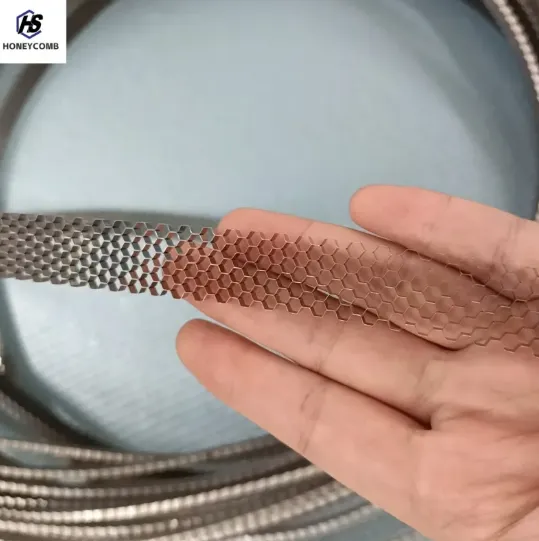
- Afrikaans
- Albanian
- Amharic
- Arabic
- Armenian
- Azerbaijani
- Basque
- Belarusian
- Bengali
- Bosnian
- Bulgarian
- Catalan
- Cebuano
- China
- China (Taiwan)
- Corsican
- Croatian
- Czech
- Danish
- Dutch
- English
- Esperanto
- Estonian
- Finnish
- French
- Frisian
- Galician
- Georgian
- German
- Greek
- Gujarati
- Haitian Creole
- hausa
- hawaiian
- Hebrew
- Hindi
- Miao
- Indonesian
- Italian
- Japanese
- Javanese
- Malay
- Persian
- Portuguese
- Punjabi
- Russian
- Spanish
- Swahili
- Telugu
- Vietnamese

Honeycomb Strips: Advanced Sealing Solutions for High-Speed Rotating Machinery
When performance, reliability, and longevity are non-negotiable in gas turbines, steam turbines, compressors, and jet engines, engineers turn to a superior sealing innovation—honeycomb strips. Designed to deliver exceptional wear resistance and efficiency in extreme conditions, these advanced components are revolutionizing the sealing industry with their unique structure and high-performance alloy composition.

Why Honeycomb Strips Outperform Traditional Sealing Schemes
In demanding environments such as turbine engines or high-speed compressors, traditional sealing systems often fall short. Labyrinth seals, brush seals, and carbon rings can experience rapid wear, thermal instability, or insufficient resilience under extreme pressure and temperature fluctuations. This is where honeycomb strips demonstrate a critical advantage.
Unlike conventional seals, honeycomb strips feature a precisely formed cellular structure that allows tighter clearances and better airflow control. Their geometric design provides excellent leakage reduction without compromising the rotor. The air flowing across the structured cavities generates a cushioning effect, preventing direct contact and reducing friction even during rotor-stator interaction. This characteristic not only improves efficiency but also extends the service life of the turbine or compressor.
Moreover, these strips can accommodate minor rubbing events, a common occurrence in high-speed rotating equipment. Instead of immediate failure, honeycomb strips maintain sealing integrity—offering both protection and resilience that surpass most traditional designs.
Material Excellence: Stainless Steel, Inconel, and Hastelloy in Honeycomb Strips
The performance of honeycomb strips is not only defined by their design but also by the materials used in their construction. Premium alloys such as stainless steel, Inconel, and Hastelloy are commonly selected for their superior properties in high-stress applications.
Stainless steel provides outstanding corrosion resistance, mechanical strength, and thermal stability. It's widely used for honeycomb strips that operate in moderate-temperature environments or where exposure to moisture or chemicals is a concern.
Inconel, a high-nickel superalloy, is ideal for extreme heat and oxidation resistance. Its exceptional performance in the aerospace and power generation sectors makes it a preferred choice for honeycomb seals in jet engines and turbine enclosures. Inconel-built honeycomb strips can withstand temperatures exceeding 1000°C without structural degradation.
Hastelloy offers robust resistance to aggressive chemical corrosion and stress cracking. It’s the material of choice when sealing components are exposed to acidic or chloride-rich environments. The use of Hastelloy in honeycomb strips further elevates their suitability for applications involving high-pressure steam or chemically reactive gases.
Each of these materials brings distinct advantages, but they all contribute to the durability, heat resistance, and sealing precision that define the modern honeycomb strip.
Honeycomb Strips:Wear Resistance that Withstands Harsh Mechanical Demands
One of the primary challenges in sealing systems is mechanical wear due to continuous rotation, vibration, and high-speed contact. Honeycomb strips solve this challenge through both their material hardness and engineered geometry.
The honeycomb structure minimizes contact area, which significantly reduces heat generation and abrasive wear during operation. Even if incidental rubbing occurs, the honeycomb cavities act as energy absorbers, helping to prevent catastrophic damage to both the seal and the rotor.
In comparison to brush seals or straight-edged components, honeycomb strips exhibit higher resistance to blade-tip wear, ensuring lower maintenance requirements and longer operational intervals. When applied in honeycomb seal gas turbine systems, this wear resistance plays a critical role in maximizing turbine uptime and operational stability.
Field data from gas turbine users consistently show lower maintenance cycles and improved thermal efficiency when honeycomb seals are integrated into the machinery. Their resilience under fluctuating loads and thermal expansion makes them an ideal solution for systems that must perform under continuous, high-speed conditions.
Applications and System Benefits in Honeycomb Seal Gas Turbine Designs
The role of honeycomb seal gas turbine solutions is increasingly vital in modern energy systems. In these complex machines, where efficiency and temperature tolerance are paramount, honeycomb strips have emerged as the preferred sealing option.
Their integration reduces leakage in high-pressure stages, enhancing the turbine’s overall efficiency. Additionally, the use of honeycomb seals minimizes rotor damage risk during shaft misalignment or transient loads—common in start-stop cycles.
In jet engines, the light weight and precision of honeycomb strips help improve thrust-to-weight ratios while maintaining high structural integrity. Steam turbines and compressors also benefit from reduced downtime, thanks to the low-maintenance nature of honeycomb strips, which extend mean time between overhauls.
Furthermore, many OEMs are now adopting hybrid sealing solutions that combine honeycomb strips with brush or labyrinth elements. This multi-layered design provides an added buffer against failure, reinforcing system safety and enhancing long-term cost efficiency.
Honeycomb Strips FAQs
What are honeycomb strips used for?
Honeycomb strips are primarily used as high-performance sealing elements in gas turbines, jet engines, steam turbines, and compressors to minimize leakage and improve efficiency.
Why are honeycomb seals better than traditional sealing methods?
They offer better wear resistance, tolerate rubbing, allow tighter clearances, and reduce friction more effectively than brush or labyrinth seals.
What materials are commonly used in honeycomb strips?
Stainless steel, Inconel, and Hastelloy are commonly used due to their superior resistance to heat, corrosion, and mechanical stress.
How do honeycomb strips benefit a honeycomb seal gas turbine system?
They enhance sealing performance, reduce leakage, extend service life, and protect the turbine from rotor damage in high-speed, high-temperature environments.
Can honeycomb strips be customized for specific applications?
Yes. They can be manufactured in various thicknesses, cell sizes, and alloy types to meet the unique requirements of different machinery and industries.
Products categories
-
Stainless Steel Honeycomb Air Straightener IntakeNewsSep.01,2025
-
Advanced Honeycomb Gas Seal: Maximize Efficiency & ReliabilityNewsAug.31,2025
-
1.6mm Honeycomb Ring Seal: High-Performance, Reliable SealingNewsAug.30,2025
-
Steel Honeycomb CoreNewsAug.29,2025
-
Stainless Steel Honeycomb SheetNewsAug.29,2025
-
Honeycomb SealNewsAug.29,2025
-
2.5mm Honeycomb Seal: High-Performance, Durable Sealing SolutionsNewsAug.29,2025















